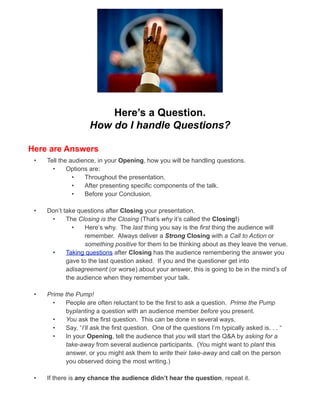
Here's a Question. How Do I Handles Questions?
- 1. Here’s a Question. How do I handle Questions? Here are Answers • Tell the audience, in your Opening, how you will be handling questions. • Options are: • Throughout the presentation. • After presenting specific components of the talk. • Before your Conclusion. • Don’t take questions after Closing your presentation. • The Closing is the Closing (That’s why it’s called the Closing!) • Here’s why. The last thing you say is the first thing the audience will remember. Always deliver a Strong Closing with a Call to Action or something positive for them to be thinking about as they leave the venue. • Taking questions after Closing has the audience remembering the answer you gave to the last question asked. If you and the questioner get into adisagreement (or worse) about your answer, this is going to be in the mind’s of the audience when they remember your talk. • Prime the Pump! • People are often reluctant to be the first to ask a question. Prime the Pump byplanting a question with an audience member before you present. • You ask the first question. This can be done in several ways. • Say, “I’ll ask the first question. One of the questions I’m typically asked is. . . “ • In your Opening, tell the audience that you will start the Q&A by asking for a take-away from several audience participants. (You might want to plant this answer, or you might ask them to write their take-away and call on the person you observed doing the most writing.) • If there is any chance the audience didn’t hear the question, repeat it.
- 2. • If you are not sure the audience, or you, understood the question, paraphrase it and ask the questioner if your understanding is correct. • If the question disagrees with your position. • Affirm that, “We have different opinions on that. Perhaps we can discuss this after the event. • If an audience member continues to attack you and/or your position. • Say, “Sorry you disagree with me. I suggest you and I pick this up later.” • No, “Good question!” • If you say that, how do you address the next question? Another, “Good question!” And the one after that. . . • Better to say, “I’m glad you asked that.” • “I’ll be covering that soon.” • “Write that down. Remind me later if I don’t answer it to your satisfaction.” • If you don’t know the answer to a question. • DO NOT answer with something you know is not correct. • You can buy time by saying, “I’m drawing a blank on that right now. When it comes to me, I’ll back track and give it to you.” • Ask the audience for the answer. About the Author Fred E. Miller is a speaker, an author and a coach. Businesses and individuals hire him because they want to improve their Public Speaking and Presentation Skills. They do this because we perceive really great speakers to be Experts. Perception is reality. All things being equal, we rather deal with Experts. He shows them how to Develop, Practice and Deliver Knock Your Socks Off Presentations! with – No Sweat! Fred E. Miller Fred@NoSweatPublicSpeaking.com nosweatpublicspeaking.com Photo Credit – US Army
